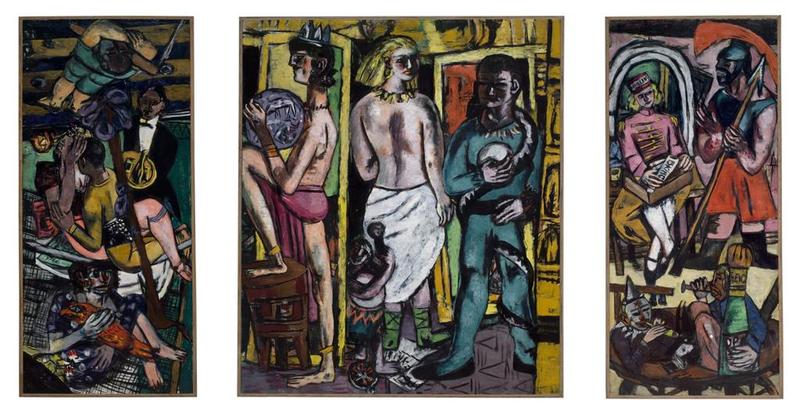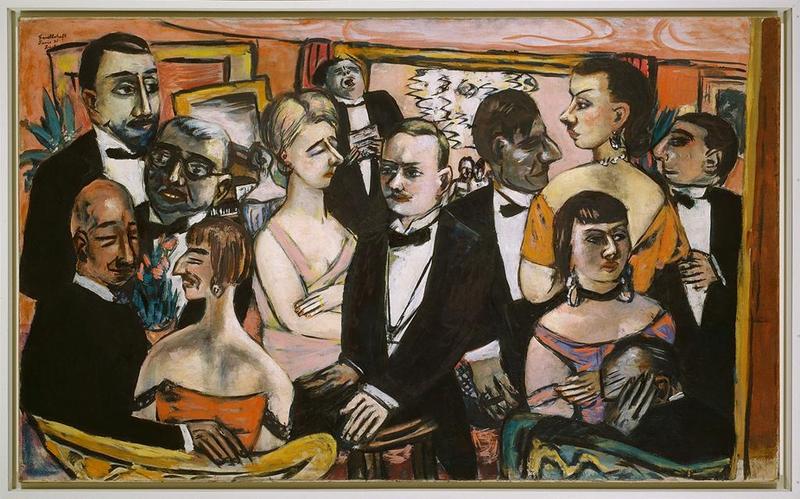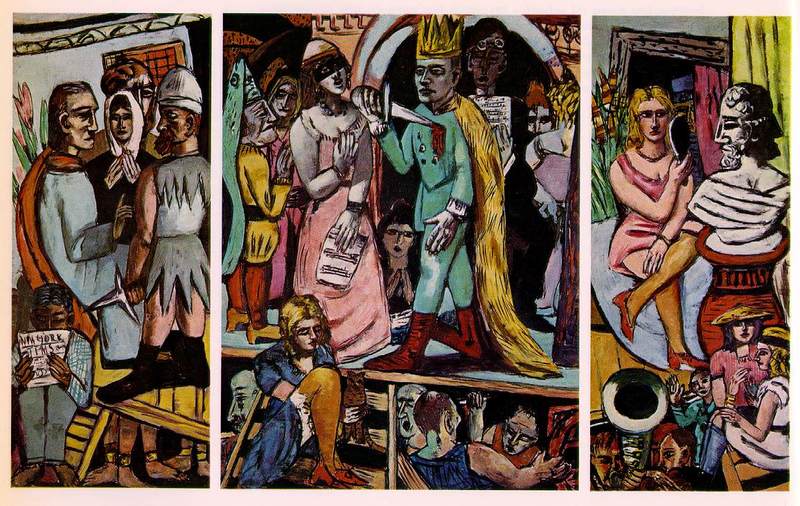The Acrobats: Modern Notions of Identity and Time as Artifice

(Cat. 1) Max Beckmann, The Acrobats, 1939, oil on canvas, left panel: 78 3/4 x 35 7/16 in.; center panel: 78 3/4 x 66 15/16 in right panel: 78 3/4 x 35 7/16 in., Saint Louis Art Museum.
Beckmann, in his 1939 work The Acrobats (Cat. 1), creates an unstable scene in which the viewer’s perception of reality and artifice is confused. Beckmann utilizes this space to conflate modern individuals with costumed figures and the artificial world of the stage not only within The Acrobats, but within Paris Society (Figure 1) and The Actors, (Figure 2) as well.[i] This prominent comparison, used often by the artist, asserts certain critiques on modern notions of identity and time: Beckmann notes the inability of modern identity to document the true self and rejects the modern association of time with progress.
Beckmann uses The Acrobats (Cat. 1) to create an unstable space in which it is difficult to discern reality from artifice. In naming the image a portrayal of “acrobats,” Beckmann alludes to the existence of a fictional performance lodged within his painting. His depiction of three characters clearly dressed as acrobats or circus affiliates further introduces to the viewer the idea that this scene may all be staged within the context of the circus. However the line dividing these fictional figures and the artificial space they occupy from the authentic world surrounding them is not drawn clearly. In addition, his painting, claustrophobically packed with figures, lacks concrete insight into the inner workings of the characters contained within them. Eight of the thirteen figures stare blankly off into space, seemingly unaware of their mutual existence.[ii] The inaccessibility of the figures is heightened even further through their simplified forms, crude facial depictions, and static poses giving little in the way of clear emotion, action, or purpose. The king and venus in the central panel stand with their backs to each other in stiff and awkward vertical postures. Through these techniques, Beckmann deprives us of information, typically used by the viewer to surmise an understanding of the characters respective personalities and to imbue them with desires, fears, and motives, such as concrete relationships or a cohesive narrative. By cutting off our access into more “substantial” indicators of character within these lackluster figures, Beckmann leaves the viewer solely with their iconic costumes and the indicators of class, role, and time period they connote from which to ascertain the identity of the figures.

(Figure 1) Max Beckmann, Paris Society, 1931, oil on canvas, 43 x 69 1/8 in, Solomon R. Guggenheim Museum.
In addition, Beckmann uses these bold caricatures to oversaturate his image with markers of conflicting time periods. Beckmann portrays a roman soldier, a Venus, and a medieval king alongside a modern day waiter, ice cream vendor, and spectator. Not only does the presence of these historical figures clash with the existence of the modern characters beside them, they themselves are culled from disparate times and places.[iii] Through the impossibility of his historical figures simultaneous existence and the inclusion of the clearly artificial acrobats, Beckmann creates a scene in which the viewer is certain that that some of these characters must be artificial, but is uncertain of which are real individuals and which are merely in costume.
Within this confusing scene, Beckmann capitalizes on the fact that only the viewers own proximity to the modern age pushes them to differentiate between the blatant artifice of the acrobats’ roles and the ostensibly authentic roles the modern waiter, the spectator, and the ice cream vendor occupy. In titling the piece The Acrobats he pushes back against our modern desire to segregate their contemporaries from the rest of the costumed characters by throwing all the figures under the umbrella of artifice. By pairing these obviously costumed figures alongside modern day people in their everyday roles, he lampoons the idea of deriving true personality, culture, history from exterior artifice, thereby equating clothing to costume. His work asserts that the “Roman soldier” is truly as much a “Roman soldier” as the “waiter” is truly a “waiter,” This statement mocks the importance occupation plays in the actualization of the self, asserting that the roles set out by modern society are as artificial as the roles seen on stage at the circus.
This theme is employed again by Beckmann in Paris Society (Figure 1). Among a room full of framed paintings, armchairs, a chandelier, grand piano, Beckmann includes tuxedos for the men and ball gowns for the women as forms of costume. Due to their omnipresence, we cannot tell anything about the characters behind them or differentiate one from the other in any meaningful way because they are all clad in the markers of this generic identity of the modern elite. In addition, their emotions, little more than bellowing howls, blank stares, and characteristically elite eyes-closed sneers, seem equally as artificial as the clothes they display: again nothing more than the things one wears when attending this sort of function. This painting is a prime example of Klaus Lankheit’s claim, that Beckmann’s paintings often portray figures merely “act[ing] out their roles.”[i] The critique of modern society lodged within Beckmann’s treatment of these figures speaks to the inability of these indicators of modern identity, much like the costumes worn by the acrobats, to document or divulge any aspect of the real self, a process Beckmann felt was central to both life and art.[ii]

(Figure 2) Max Beckmann, The Actors, 1942, oil on canvas, center panel: 78 3/4 x 59 1/16 in, side panels, each 78 3/4 x 33 1/2 in., Fogg Art Museum.
The Actors (Figure 2) utilizes yet another device to conflate modern society with the stage. The viewer is made hyper aware of the divide between the artificial nature of the painted stage and the apparent reality outside of it through two jarring scenes: the scripted and feigned nature of the stabbing on the stage and the violently real nature of the stabbing below it. Within the bottom of each panel a character clad in modern wares sits in a purgatorial space between the real world and the stage.[vii] All three paintings position the modern figures in a grey zone, not quite a member of the stage, but not clearly apart from it either. It is unclear whether or not these figures populating the bottom of the image are actors dressed as modern characters on their break, or real spectators.
In his essay on Max Beckmann’s Triptychs, Charles S. Kessler highlights another aspect of The Actors (Figure 2) that is central to Beckmann’s critique of modern notions of time. He refers to the explanation of Erhard Göpel, a German art historian and contemporary of Beckmann’s, and a champion of his work. Göpel states that the scene in the left panel reenacts an incident Beckmann himself witnessed between his artist friends and the German police.[viii] In depicting the officer as a medieval soldier, Beckmann rejects the modern notion that the movement from one time period to another is associated with progress. He asserts that we have not progressed at all, noting that brutish soldiers still exist, just in different costumes. This equation is furthered by Beckmann’s inclusion of equal amounts of psychological dimensionality, awareness, or levels of humanity within his figures regardless of the time periods to which they belong. His even judgment, applied consistently across figures from different eras, stands against the modern mind’s desire to think of themselves as inherently more evolved than their pre-modern predecessors.
A similar treatment can be found among the characters within The Acrobats (Cat. 1). Beckmann notes the constructed nature of time in his essay “Letters to a Woman Painter” commenting that, “time is the invention of humanity.”[ix] Within The Acrobats Beckmann alludes to the human invention of time through his inclusion of incongruent markers of time culled from the various epochs from which his disparate characters came. The central panel’s clock, drum, and cosmic sphere stand as different tools instituted by man to document the existence of their fiction. Both The Actors and The Acrobats seem to pin time as one of the “veils” or “walls” he refers to within his diary, set up by “foolish seekers” to hide the worlds natural “life.”[x]
In The Acrobats, Paris Society,and The Actors, Beckmann destabilizes the stability of modern notions of time and identity. Achieved through a conflation of time periods that seem separate and distinct to the modern mind, and the comparison of the modern individual to costumed figures and the world of artifice, Beckmann highlights the inability of modern identity to document the true self and rejects the authority of modern time and its associations with progress.
[i] Charles S. Kessler’s text discussed throughout this essay outlines Beckmann’s interest in this conflation and his conception of “life as theater” within the last two pages of his introduction. Charles S. Kessler, Max Beckmann’s Triptychs (Cambridge: Belknap Press of Harvard University Press, 1970).
[ii] Max Beckmann, Self-Portrait in Words: Collected Writings and Statements, 1903-1950 (Chicago, Ill: University of Chicago Press, 1997), 22.
[iii] “sleepwalkers…another,” Kessler, Max Beckmann’s Triptychs, 2.
[iv] This conflation of time and space in Beckmann’s work has also been explored by Robert Storr, “But there…contiguous sections (…) represent a…single context,” Robert Storr, "The Beckmann Effect," Max Beckmann (New York: Museum of Modern Art : [Distributed in the United States and Canada by D.A.P./Distributed Art Publishers], 2003), 36-37.
[v] Klaus Lankheit was a prominent German art historian (1913-1992). Kessler, Max Beckmann’s Triptychs. 6
[vi] “To become a Self is the urge of all yet unreal souls. It is this self for which I am searching for in my life and in my art.”[vi] This quote reveals the integral and central role ascertaining the true self played within Beckmann’s work and helps to explain one reason why he may have found it necessary to compare the modern idea of identity to artifice. Ibid. 8
[vii] These figures are noted by Charles Kessler to represent “ordinary bourgeois ‘life’” Kessler, Max Beckmann’s Triptychs, 56.; This liminal space is provided by the steps in the left and central images and the ledge between the stage and the pit within the right panel.
[viii] Kessler, Max Beckmann’s Triptychs, 56.
[ix] Beckmann, Self-Portrait in Words, 314.
[x] Beckmann, Self-Portrait in Words, 30.